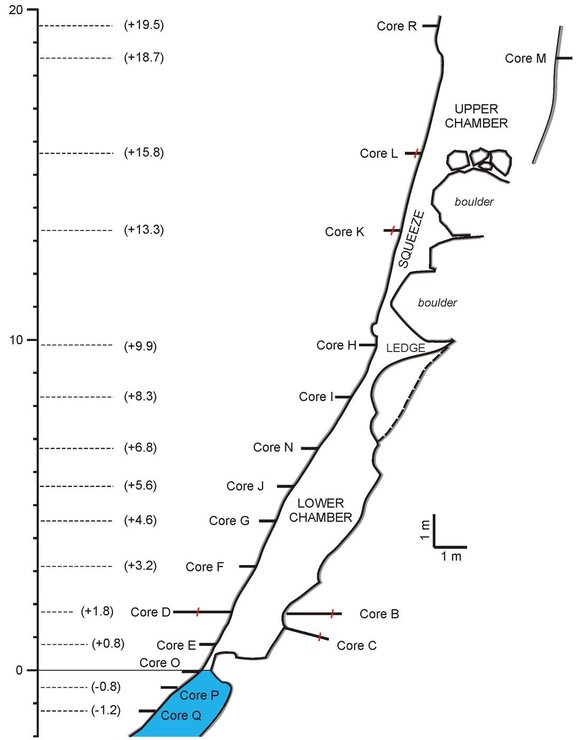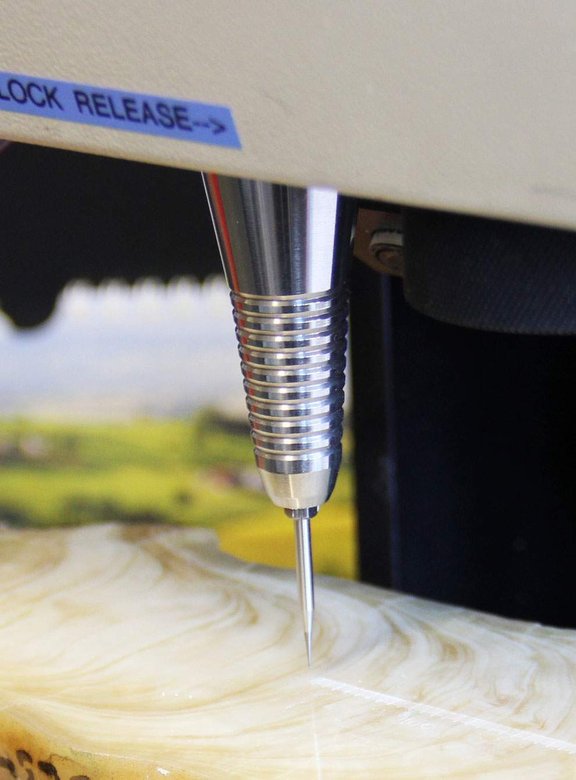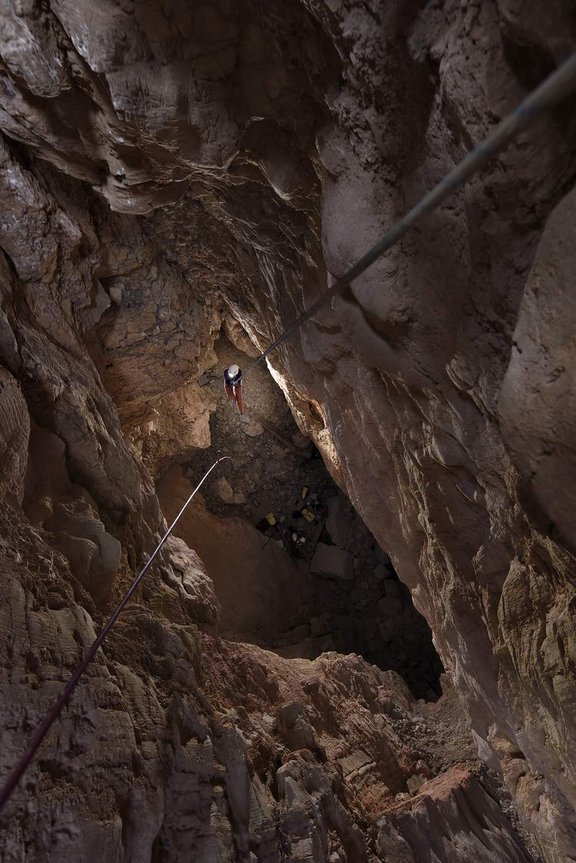DEVILS HOLE
Geologists from the University of Innsbruck search for ancient traces of our climate history.
Office of Public Relations of the University of Innsbruck
May 2017
Diving in the cavern: Beneath the surface of the Amargosa desert, located in southwestern USA, lies a hidden ‘gem’ for climatologists that harbors a complete history of climate evolution spanning a million years. Geologists from Innsbruck are studying this climate record which is found both above and below the present day water table.
“Apart from ice in the polar regions, caves are one of the most important climate archives we have. The Earth’s surface is exposed to weathering and erosion and constantly changes. In caves, however, the footprints of the past are well preserved, sometimes over many hundreds of thousands of years,” Yuri Dublyansky explains. The geologist has spent his entire scientific career studying caves and, in particular, a type of deposit known as speleothem or, in other words, cave minerals.
The climate calendar begins the moment the first drop enters the cave and calcite is deposited.
Yuri Dublyansky
The most well-known cave deposits are dripstones, such as stalagmites, which grow up from the ground, or stalactites, which hang from the roof of a cave. They are created when water, for example rain water, from the surface seeps through the ground taking up calcium carbonate as it travels through the soil and bedrock. Once it reaches the cave, the droplet—filled with chemical information about the climate above—may deposit onto the surface of a stalagmite, creating a new layer of calcite. “A climate record begins the moment the first drop enters the cave and calcite is deposited: Year after year extremely thin layers of calcite are added, which enable us to study the climate of the distant past,” Dublyansky explains. “In other words, this is calcified precipitation.”
Rappeling down into Devils Hole 2
Information about ancient climates can be derived in a number of ways. For example, scientists at the University of Innsbruck measure the ratio of oxygen’s heavy to light isotopes within individual calcite layers, which provide clues to past temperature and rainfall conditions.
Scientists can precisely date the climate record up to hundreds of thousands of years back in time using uranium-thorium techniques. This dating technique has also been used in the current project.
It wasn’t dripstones, however, that led Yuri Dublyansky and his colleagues Gina Moseley, Kathleen Wendt and Christoph Spötl from the Quaternary Research Group of the Institute of Geology to Death Valley at the beginning of February 2017. In fact, dripstones do not exist in Devils Hole; instead an even more fascinating source of information can be found there. “Dripstones have a downside: When the climate is drier they may stop growing and the climate record becomes incomplete. The situation in Devils Hole is very different though,” says Dublyansky.
Devils Hole is located in Death Valley National Park, Nevada, in the middle of the Amargosa desert. The subaqueous cavern provides information on the extensive subterranean water reservoir it intersects.
Smooth walls
The walls of Devils Hole are coated from top to bottom with a calcite layer that has a thickness of more than one meter at some places. “Here it is not dripping water that causes the build-up of mineral deposits but rather the groundwater moving slowly through the cavern,” says Dublyansky. “The groundwater in this desert region is slightly supersaturated with calcite, which is slowly depositing in layers on the cavern walls.” The exciting fact: This process has been happening for over more than a million years without any interruptions. “This is why Devils Hole is a hidden gem for climatologists: Finding a nearly complete documentation of the chemical composition of groundwater is unique worldwide,” says the geologist. In 2014 this project received a grant from the Austrian Science Fund (FWF) – Austria’s central funding organization - and since then has been headed by Christoph Spötl.
Devils Hole is a hidden gem for climatologists.
Yuri Dublyansky
The team of geologists from Innsbruck has been studying Devils Hole, or more precisely a nearby cave called Devils Hole 2, since 2010. Devils Hole proper is off limits to visitors and researchers as its water provides a habitat for the endemic Devils Hole Pupfish: These small blue fish are the only naturally occurring population in the world, consisting of only about 100 fish. The pupfish have been heavily protected since they were declared an endangered species
Devils Hole 2 is located about 200 meters away from Devils Hole proper. It has an upper and a lower chamber, is almost vertical and, in some places, quite narrow. Throughout the cavern, the scientists from Innsbruck extracted samples of the calcite deposits with a special drill (see map) - above and below the groundwater table.

Cross-sectional survey of Devils Hole 2:
16 cores have been extracted so far, two of them under water. A quick glance at the scale shows: There is not a lot of room for movement. The slogan is “squeeze”.
A drill that breathes
For collecting the calcite samples, the geologists used a powerful drill, which can produce cylindrical cores of 2.5 centimeters in diameter. The drilling takes time and patience: “You have to drill extremely carefully to avoid breaking the cores. It takes us about 2.5 hours for 50 centimeters,” explains Dublyansky.
The scientists have a lot of experience with taking samples of speleothems from all over the world – but usually this takes place in a dry environment. Devils Hole 2 posed a new challenge: Several years ago Yuri Dublyansky and Christoph Spötl decided to extract cores from this cavern, including from below the water table. “We want to use these samples to reconstruct the climate as far back as possible and part of it is to investigate the movement of the groundwater table,” says the geologist. “To do that we need samples from several places in the cavern and some of these are under water.”
This type of drill cannot be bought in a hardware store.
Yuri Dublyansky
This is why the geologists needed to make certain adaptations to the drill so that it could operate also under water. “Since you cannot buy this technology, we had to build it ourselves,” explains Yuri Dublyansky. A specialist in Germany developed a customized dry suit for the drill. “In addition, we designed a special plastic attachment, which was produced on a 3D printer, to prevent water from getting into the drill.” Before this special drill was used in the USA, Dublyansky and Spötl had already tested it several times, for example in the Achensee, the Tyrol, Austria:
Testing the drill in the Achensee, Austria.
The drill tests were successful and at the beginning of February the team started their trip to Nevada. For two weeks they worked together with colleagues from the University of Minnesota investigating and taking calcite samples from Devils Hole 2. Apart from other cave divers, they were accompanied by professional cave photographer Robbie Shone. He kindly provided his videos and photos for this report.
Yuri Dublyansky had to drill extremely cautiously when extracting an undamaged cylindrical calcite sample. Photographer Robbie Shone accompanied him on the dive.
Learning from the past
Yuri Dublyansky extracted two cores while diving: He received air via a long hose that was connected to a compressor rather than through a dive tank. “Because cave diving is considered a dangerous activity, we would have needed an additional certification to be allowed to use conventional SCUBA equipment in Devils Hole,” says the geologist. Using the hose, Dubylansky was able to stay under water for about four hours straight: “The water had a temperature of about 35 degrees Celsius, which was a comfortable temperature to work in.”
Yuri Dublyansky and Kathleen Wendt, pleased about the successful boring.
In addition to the new analysis to date the calcite deposits, the researchers also studied the fluctuations of the groundwater table. The results show that about 20,000 years ago the water table was about nine meters higher. Thus, the research team is able to reconstruct dry and humid periods in this part of the USA, which also adds another piece of the puzzle to our understanding of climate evolution. These results provide an important historical data set of the southwestern part of the USA, which today suffers from frequent and prolonged droughts. “We still don’t understand completely the climate evolution that took place in the past hundreds of thousands of years. To be able to predict future climate changes, we have to look very closely at what happened in the past. The calcite deposits of Devils Hole enable us to do so,” says Dublyansky.
Back in Innsbruck, the scientists have to comprehensively analyze and date the cores, which the geologists transported under great care in their hand luggage back to Austria.
First, the cylindrical cores are cut open in the middle and polished. “From these halves we extract very small amounts of the deposits by using a computer-controlled milling machine with the smallest available drill bit (0.3 mm diameter). We then date the sample with the uranium-thorium technique,” explains Dublyansky. “At the moment, the oldest samples we have dated are about 750,000 years old. But we are still working on extending the timeline even farther back. Calcite grows extremely slowly in Devils Hole: a little bit less than a thousandth of a millimeter per year. Some cores are more than one meter long. Analyzing and dating to a million years back into the past is definitely feasible. This is what we are doing right now.”

Small traces of the samples are sufficient for analysis in the lab.
A passion since childhood
Since childhood days, caves and their particularities have played an important role in Yuri Dublyansky’s life. As the son of well-known cave researcher Viktor Dublyansky, the geologist was introduced to caves and the fascination they hold early on. “My earliest childhood memory goes all the way back to toddler age: My dad took me with him to a cave when I was about three years old. We lived at the Crimea, where there are a lot of caves. Because it is rather warm there, we weren’t much used to snow. My first visit to a cave took place in summer and below the cave entrance I saw a huge pile of snow. I still have this picture of the snow pile - in summer at that cave – in my head,” the geologist tells. Even after 30 years of research, caves still haven’t lost their allure. Not even those he thinks he already knows quite well:
Every little square centimeter of the cavern may be interesting.
Yuri Dublyansky

© University of Innsbruck, May 2017
Text
Melanie Bartos
Photos and videos:
Robbie Shone

